| Please access the following URL if you want to secure using SSL. All pages in the site will be secure pages. |
| https://secure02.blue.shared-server.net/www.fish-food.co.jp/message english 3.2020.html |
Welcome to FISH FOOD TIMES
Mar. 2020 issue No.195

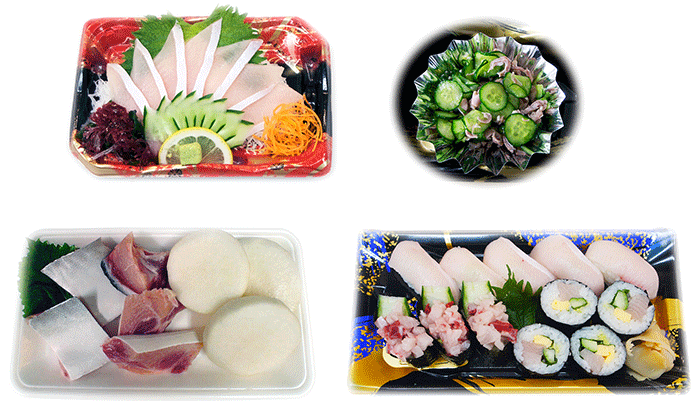
japanese amberjack products
Cultured Japanese amberjack prices remain low
While the market price of cultured amberjack is moving at the plateau market, the price of cultured japanese amberjack is almost half as of February. The abundant landing of natural Japanese amberjack nationwide since last year seems to be one factor that has pushed down the market.
In addition, the company seems to have implemented a plan to enrich the quantity of cultured fish of the pond in anticipation of exporting cultured amberjack overseas. However, exports were lower than initially expected due to factors such as the slump in the Chinese economy caused by the friction between the United States and China, and the rise in export prices of cultured Japanese amberjack. And domestically, it became oversupplied with stock, and as a result, the domestic market seemed to be sluggish.
Japanese amberjack's fish culture business company missed its export calculations. For this reason, they concentrated on exporting Japanese amberjack to live fish carriers of red sea bream together from Japan to Korea in order to export a large quantity of the amberjack's the quantity of cultured fish of the pond. As a result, sales have recently increased dramatically, nearly doubling compared to the previous year.
But how long will this momentum continue? From February onwards, global economic activity has been stagnant due to the impact of the new coronavirus, so it should be seen that the outlook for the future is becoming very questionable. In other words, if the culture of Japanese amberjack, which has the enrich the quantity of cultured fish of the pond, currently loses momentum in South Korea, which is relying on these digestions, the market recovery of the culture of Japanese amberjack may be farther away.
Japanese amberjack handling environment
As a trend of natural japanese amberjack, which greatly affects the market price of cultured japanese amberjack, generally the season of spawning will be reached after the peak of catching. The timing of spawning varies from region to region, for example, the Satsunan region south of Kyushu is around March, the offshore area of Shikoku and Kyushu is around April, and the sea area of the Sea of Japan such as Noto Peninsula is around June, The standard is when the seawater temperature reaches 19 ��.
After the spawning season, the natural japanese amberjack that is caught in each region loses fat because of the nutrition of the fish by spawning, so the natural japanese amberjack at this time becomes less delicious. In the case of cultured japanese amberjack, the conventional method was to collect the natural mojako spawned by natural japanese amberjack and grow it to the size of the shipment over about three years. Recently, the culture fish company has grown fry fish grown from fully cultured artificial seedlings by artificially controlling water temperature and light, and can lay eggs four months or six months before normal times. By this method, a cultured japanese amberjack has emerged, which is the reverse of the natural japanese amberjack, with the season coming from spring to summer.
Fillet or sashimi of natural Japanese amberjack from spring to summer after the spawning season has a problem that color change is very fast, and color retention is poor, so that price cuts frequently occur. However, the cultured japanese amberjack with artificial spawning control has the advantage that it does not lose fat even in the spring and summer, and the fish body is full and it is difficult to discolor, so there is an advantage that price reduction does not easily occur.
Cultured Japanese amberjack that has specially controlled artificial spawning is branded and sold, and is not easily bargained to maintain its brand value. Therefore, they cannot be purchased at the same price as the current national sluggish market. However, it seems that it is difficult to do business ignoring the general market price currently circulating at present. The current market situation of cultured Japanese amberjack seems to be facing a difficult situation even for cultured Japanese amberjack traders who are taking such a differentiation strategy.
Considering why the Japanese amberjack does not sell at a low price, and the greater amberjack sells at a high price, it seems that the biggest factor is also the rapid change in physical color. Fisheries personnel in the fish section have long since made their products, discolored and devalued, and are very reluctant to lower their prices. For this reason, he wants to use a greater amberjack, which has a feature that discolors more slowly than a Japanese amberjack, even if the price is slightly higher.
However, the current rate of the greater amberjack is not a little higher than that of the Japanese amberjack, and the price difference is twice as high. Is there still any benefit to the greater amberjack? When I think of this as a person involved in the business dealing with fish, I have to say that this is a strange situation that can not be overlooked.
Businesses shouldn't increase their sales just by choosing safe methods with less risk. Being prepared for the risk of discoloration, if you can create a product that is more attractive than that and if you can do business that speeds up product rotation, you should be able to increase profits as well as sales.
What should we do for that? I would like to give a hint to review Japanese amberjack as a product below.
Japanese amberjack three major familys
Nowadays, most of Japanese amberjack and greater amberjack work in the fish workshop with half bodies in vacuum bags. So the difference between "japanese amberjack theree major familiys", which is a Japanese amberjack and a greater amberjack with a yellowtail amberjack added, seems to be that some fisheries personnel may not be able to clearly see the whole fish. Let's just touch.
In FISH FOOD TIMES, the difference between Japanese amberjack theree major familiys was described in the past for �� 59 fukugi figure sashimi (November 2008), so please also refer to this. The following image was used in the article at that time.
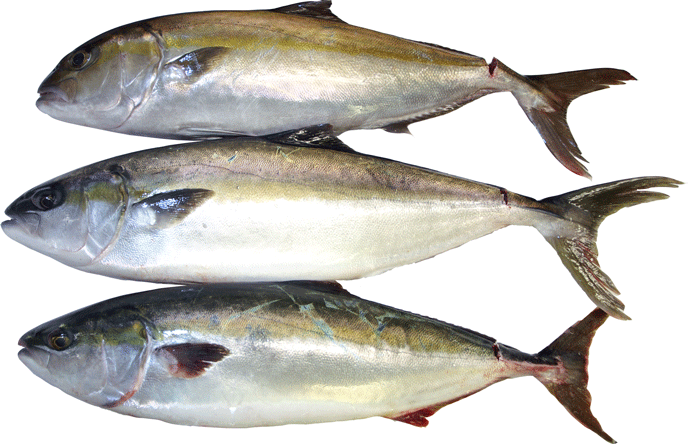
At that time, I used to ask questions and changed pages, but this time I would like to explain it straight without playing.
In the image above, three similar fishes, Japanese amberejack, greater amberjack, and yellowtail amberjack, are all Perciformes order, Carangidae family, Seriola genus, and are like siblings. Unless you are familiar with these three fish species in round fish, it is probably not easy to distinguish the differences.
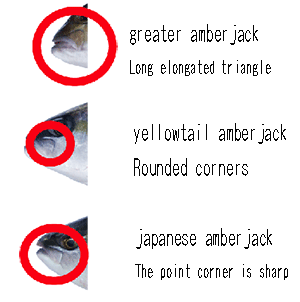
The appearance is very similar, but the texture is slightly different. japanese amberjack is greasy and rich, flesh is soft, yellowtail amberjack is clear and firm, has a light taste, greater amberjack is just in the middle of it, not too hard as the yellowtail amberjack and too soft as the japanese amberjack, it has less fat than Japanese amberjack, and has less light taste than yellowtail amberjack.
As shown in the image below, natural japanese amberjack has a smart fish body and large tail fins to enhance its ability to swim in rough seas. However, since the cultured japanese amberjack is surrounded by a living cage and does not require high swimming ability, the tail fin is degenerate and small, and the body is thick and fat. (For details about yellowtail amberjack, please refer to FISH FOOD TIMES No.141 yellowtail amberjack fillet figure (September 2015 issue), which uses images of this natural japanese amberjack.)

In companies where the rationalization of operations is important in the fisheries sector, it is often the case that a cooked culture japanese amberjack, usually in a vacuum bag, is cooked from a half-body state. It seems that handling such a round Japanese amberjack is about the time when natural japanese amberjack arrived in winter, and it seems that there is not much connection to the round fish, so also about the round fish japanese amberjack I want to touch a little.
Mottainai of Japanese
One method is to utilize the internal organs that come out of the whole fish when it is cooked. It may be natural for many people to discard fish guts, but in fact, not only squid shiokara, but also ayu and bonito shiokara are fermented fish guts. In Japan, fish internal organs have long been used without discarding, as it is "mottainai" to simply throw away fish internal organs.
Recently, the word "Sustainable Development Goals" has been attracting attention, and among them, "food loss" has become a hot topic. The movement of the SDGs seems to be modeled on the spirit of “Mottainai” in Japan. For example, it is thought that fermented foods called shiokara, which makes use of the internal organs of fish, may be used as a model.
So, let's give it a different opportunity to mention shiokara, and let's introduce products that make use of the Japanese amberjack's internal organs. It is a vinegared product using a Japanese amberjack stomach. The farmed Japanese amberjack used as the material should be grown in an environment with good hygiene and carefully selected food, and should be managed with the best freshness. Therefore, many of its internal organs must be of great freshness, and it is a product that uses only its stomach.
The image of the process of dismantling and processing the stomach may not look very good and may seem rather unpleasant. The following images from (1) to (7) are omitted,
(1) Open the stomach with a kitchen knife, (2) scrape off the mucous membrane and dirt on the inside and outside of the stomach with a kitchen knife, (3) knead together with salt, (4) wash with water, (5) with boiling water Boil, (6) cut into two to three cm long strips vertically, and (7) cut the strips that have been cut vertically to the side.
And, from the subsequent process to the finish, the image will be described below.
| How to make vinegar using Japanese amberjack's internal organs |
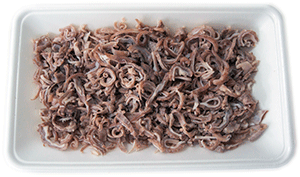 |
| 1�CChopped into elongated shapes Japanese amberjack boiled stomach (3 fish) |
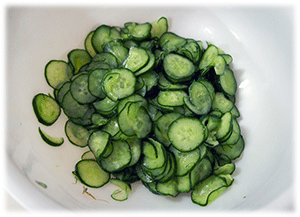 |
| 2�CKnead together with salt the sliced cucumber, and after about 15 minutes, rub it by hand and squeeze out lightly. |
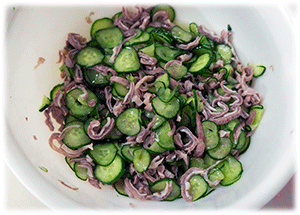 |
| 3�CTo the cucumber slices knead together with salt, add the stomach with Japanese amberjack cut into small pieces and mix with sweet vinegar. |
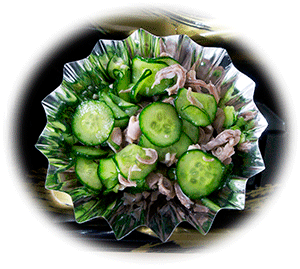 |
| vinegar using Japanese amberjack's internal organs |
Hakata has a delicious specialty dish called “Gyumotsunabe” that uses the offal of beef. This vinegar using Japanese amberjack's internal organs also has a crunchy texture peculiar to internal organs, and those who like Hakata's gyumotsunabe will surely like this dish.
Furthermore, this is not "mottainai", but one example of how it can be done in a different way from commercialization, though it is originally a popular product. The idea is to use the Japanese amberjack's a collar of a fish as a fillet for hot pots as well as grilled salt.
| Japanese amberjack's a collar of a fish fillet |
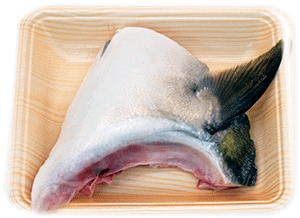 |
| 1�CJapanese amberjack's a collar of a fish is worthwhile because its edible portion is large if its size is large, but small ones are low in value and tend to be difficult to sell unless their selling price is low. |
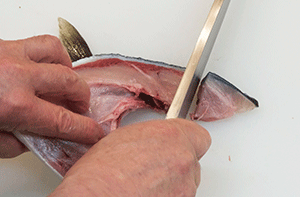 |
| 2�CTherefore, the smaller ones are cut into smaller pieces to make them easier to eat. Since it cuts hard bones, a sharp knife is needed. |
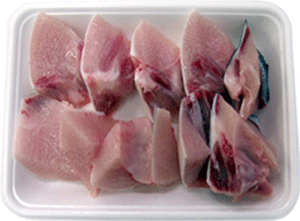 |
| 3�CCut from one bite to two bite-sized pieces, and make a serving that shows that there are many edible parts. |
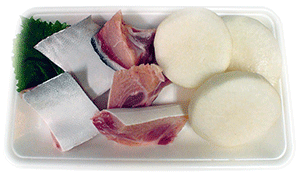 |
| 4�CAs a further application, small cut Japanese amberjack's a collar of a fish fillet is served with radish and commercialized as “Buri Daikon”. |
Commercialized value-added commercialization of cultured japanese amberjack
Fillets and tanzaku are too common, so I won't mention them here. Rather than that, I would like to introduce the following sashimi and sushi products that will give you hints that you can easily make profits and make sales.
Japanese amberjadk's back body is more likely to be used for fillets. Also, when making the back body sashimi, it is thought that hiratsukuri sashimi is almost exclusively, not going to usutsukuri sashimi. On the other hand, in the case of belly body, you can of course use hiratsukuri sashimi, but by using usutsukuri sashimi or sogitsukuri sashimi, you can create a variety of commercialization, so let's commercialize using belly body.
| Value-added commercialization using belly body | |
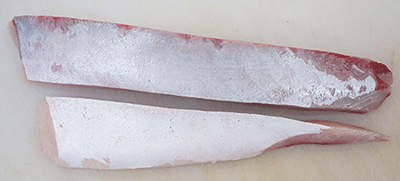 |
|
| 1�CSeparate the Japanese amberjack's belly body vertically. | |
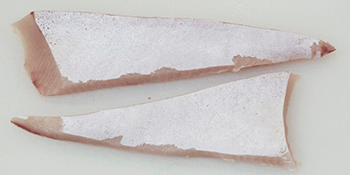 |
|
| 2�CThe upper part is the upper body, the lower part is the toro part of the lower body | |
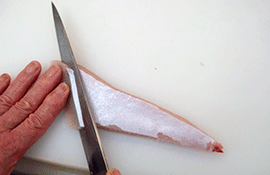 |
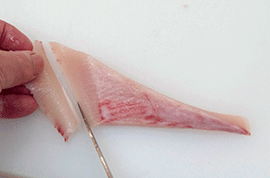 |
| 3The upper body usutsukuri sashimi should be cut with the skin side up. | 3�CThe lower body sogitsukuri sashimi should be cut with the skin side down. |
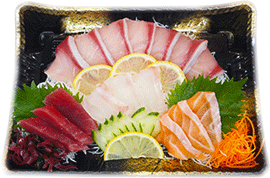 |
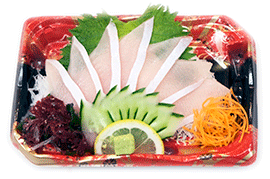 |
4-1�C 7 slices of belly body of japanese amberjack and 3 slices of raw tuna, red sea bream and raw salmon |
4-2�C The toro part of japanese amberjack is served in 7 slices by sogitsukuri sashimi, but its weight is about 40g, so the cost is surprisingly low. |
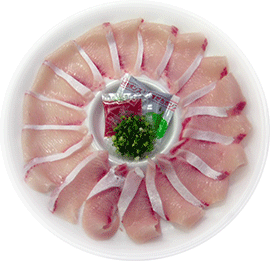 |
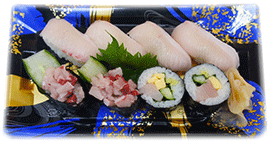 |
4-3�C The belly body of japanese amberjack was made sougitsukuri sashimi so that kirikado of sahimi would stand and look better instead of usutsukuri sashimi. |
4-4�C Sushi dane is cut so that the koba stands out, cymaki sushi uses a half-shaped part, and gunkan sushi uses a kiridashi part. |
Importance of Japanese amberjack consumption as food culture
Japanese amberjack is a fish that is so representative of Japan that it is called "eastern salmon, western japanese amberjack". Similar to salmon "Aramakisake", Japanese amberjack is called "shioburi" and has a history of being treated as a representative fish in western Japan.
In the Fukuoka district where the author lives, the zouni dish for New Year is Japanese amberjack. At the end of the year, a family in the same Fukuoka district where his son married visits his wife's village with one large natural Japanese amberjack. And there is a custom of passing "Yokayomeburi" to his wife's parents.
Japanese amberjack, which has long been treated as one of the representative ingredients in Japanese fish dishes, has maintained its position because its basic taste is first-class. The taste is unquestionable, so if you treat them roughly, you'll be disregarding one of the fish that is the basis of Japanese food culture.
Among young people at this time, sushi using raw salmon, the representative of the east, is very popular, and I feel that there is not much interest in eating Japanese amberjack, the representative of the west, with sushi. Is it only me? I think Japanese amberjack toro nigiri sushi is no less inferior to raw salmon, but there is a real problem as to how much Japanese amberjack toro nigiri sushi is sold as a product.
It has been pointed out that the market price of cultured japanese amberjack has been moving at almost half the value of greater amberjack because the production volume is too large for the demand and the supply is too large. However, as shown in the graph below, it is an order of magnitude less than Norwegian salmon in production.
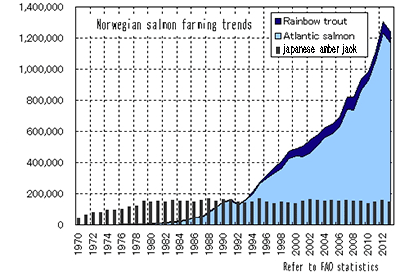
The pond of the domestic farming area is full of cultured japanese amberjack, despite the orders of magnitude less than Norwegian salmon.
The author does not say that the price of Japanese amberjack is high, but rather the attitude of retailers who do not use cultured japanese amberjack, which is changing at such a low price, as product material. I would like to say that it is strange that the fisheries staff is only interested in the great amberjack, which has a slow color change and low risk, and does not look at the cheap and delicious Japanese amberjack.
apanese amberjack is considered to be an endemic species of Japan, and is one of the fish that represent fish based Japanese food culture. Fish retailers should refer to this month's issue of FISH FOOD TIMES for some information, so that Japanese amberjack farmers have to rely on exports to survive. I want you to work hard to expand sales.
| Please access the following URL if you want to secure using SSL. All pages in the site will be secure pages. |
| https://secure02.blue.shared-server.net/www.fish-food.co.jp/message english 3.2020.html |
An opinion and the communication are to iinfo@fish food times
Date of updating 1 Mar. 2020
